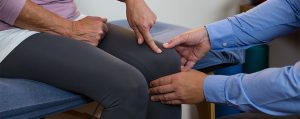6 Ways A Vestibular Physical Therapist Can Help You Put Falls in the Past
A National Council of Aging (NCOA) study found that one out of four Americans over 65 falls each year. However, falls do not only occur in older adults. A recent study found that 48% of young adults have fallen at least once in their lives, followed by 25% falling more than once and 10% reporting an injury from a fall, most commonly from participating in sports or walking across males and females2. While some of these falls may not be avoidable, many are.
Signs You’re At Risk For A Fall And What To Do
Falls are a significant concern for many people, especially as they age. They can lead to serious injuries, decreased mobility, and a loss of independence. However, the good news is that falls are often preventable. Recognizing the signs that you’re at risk and taking proactive steps can significantly reduce the likelihood of a fall. In this blog post, we’ll explore the common indicators that you or a loved one might be at risk for a fall and provide actionable strategies to help keep you safe.
Am I At Risk For Falls?
A fall is something that nobody wants to experience. They can leave us or a loved one with bruises, scrapes, broken bones and worse. But how do we know if we are at risk for falls? Answer the questions below to see if you are someone that is at a higher risk for falls and learn the resources available to help prevent a fall from occurring.
11 Reasons You Should Start Protecting Your Joints in Your 20s and 30s
With balance and strength declining as we age, often after the mid-50s, you may think that you don’t need to worry about improving these skills until much later in life. The truth is that maintaining physical fitness throughout your 20s and 30s comes with a number of benefits that can help set you up for better overall health long-term. Let’s take a look at a few key reasons why it’s never too early to start prioritizing your joint health.
Fall Prevention for a Loved One Who Lives Alone
Do you have a loved one who is a little unsteady on their feet, has a history of falls, or is too “stubborn” to use a cane or rolling walker? Here is a quick list of tips to help keep their home as safe as possible.
How Your iPhone Can Help Decrease Your Risk of Falling
With advancements in technology, detecting a fall is easier than ever! Apple Watches have been able to detect a fall for some time, a feature automatically added for anyone 55 years and older. Emergency medical response teams may even be called based on one’s movement, or lack thereof, after the impact or fall. However, the latest feature – Walking Steadiness – available on the Apple iOS 15 update now allows the phone to send you a notification related to the steadiness of your walking. This update can help recognize your risk for falls before they happen.
Fall Prevention: Tips to Prevent Falls
Mary Lehnen, PT, DPT and Laura Flanigan, MSOT, OTR/L
Why is fall prevention important? Physical and occupational therapists frequently treat patients whose injuries were caused by a fall. According to the Centers for Disease Control and Prevention (CDC), falls are the leading cause of fatal and nonfatal injuries for adults who are 65 years and older. Falls can lead to serious nonfatal injuries, including fractures of the head and hip. A fall on an outstretched hand, also known as a “FOOSH” injury, can lead to fractures and soft tissue tears of the hand, wrist, forearm and even the shoulder. Falls can be emotionally traumatic to some patients and they may avoid participating in exercise, leisure and necessary daily activities due to fear of falling. This can lead to deconditioning, isolation and negatively impacting an individual’s overall well-being and independence.
Are You at Risk for Falling?
The fall season is almost over for 2019, but for adults over the age of 65 the fall season never ends. According to the National Council on Aging, one out of every four older adults fall each year and of those seniors who fall, every 11 seconds they go to an ER. What’s even more alarming is that every 19 minutes someone dies from a fall related injury. Falls are the leading cause of fatal and non-fatal injuries in senior citizens.1
